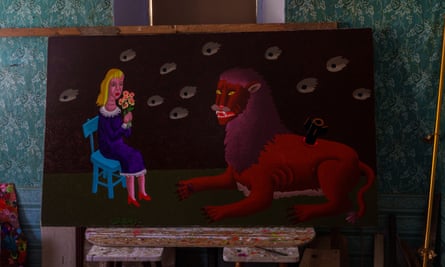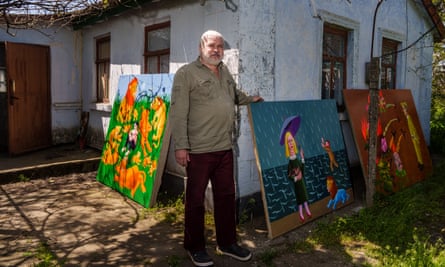Dmytro Moldovanov awoke to what sounded like a loud knocking. It was 4am on 24 February 2022 and the Russian army had just invaded Ukraine. “I looked out my balcony window and saw a plane. There were explosions. I felt the pressure wave,” he recalled.
Moldovanov, who lived next to a military aerodrome in the southern port city of Mykolaiv, downed a shot of vodka and went out into the street. Neighbours were building barricades using bins and tyres. Between them, they gathered three hunting rifles and a couple of molotov cocktails – not enough to stop an enemy tank.
When he returned home that day, he said, he was feeling “pretty twitchy”. “I thought my life was about to end. I began painting. Then I calmed down,” he said.
Moldovanov is Ukraine’s leading primitivist painter. His large-scale, brightly coloured canvases are rich in symbolism and filled with beguiling animal figures – lions, leopards and tigers. The canvas he was working on when Russia launched its full-scale attack is titled Hearing the Wolves. It shows three deer, one of them with its head down, antlers lowered.
Another work depicts the artist sitting on a chair in carpet slippers as fire falls around him. Tiny people flee, one of them pushing a pram. Buildings burn. On the right of the frame is a green-striped tiger spewing ash. There are busts of Russian rulers – Ivan the Terrible, Peter the Great and Lenin. Joining them in a row is Vladimir Putin, a grisly severed head.
Moldovanov’s style captures the horrors of war in a striking and highly original way. The Russian invaders appear as small, nightmarish creatures: multiheaded snakes and a tank-animal with a gun for a snout. Missiles marked with a Z – the symbol of Moscow’s invasion – streak across a brown sky. A Cossack warrior with five arms dances and tramples on mini demons.

“Putin is the devil, a Mephistopheles. When he goes, there will be an enormous battle in Moscow for power,” Moldovanov said. “Putin is a concentrate of what Russians believe. They have been trying for centuries to wipe out Ukrainian identity, ever since the time of [the Cossack leader] Bohdan Khmelnytsky. I try to explain the meaning of this Russian fascism.”
The artist describes his style as symbolist. One inspiration was the late 19th- and early 20th-century Georgian painter Niko Pirosmani; another the French post-impressionist Henri Rousseau. In 1988, when Moldovanov was studying art in Odesa, the dominant style was Soviet realism. Students were expected to produce watercolours using a light aquarelle technique.
Instead, he worked in gouache, a bolder medium. “I’m a person of the south. We love bright, vivid colours,” he said. The end of the USSR and the dawn of Ukraine’s modern independence allowed artists to experiment with new forms including surrealism and abstraction. Moldovanov earned a living decorating shops and businesses, and for a time worked as a builder.
For the last seven years, he has been a full-time artist. He bought a tumbledown cottage in the fishing village of Parutnye, 25 miles (40km) south of Mykolaiv. Nearby is Olbia, a Greek Black Sea settlement founded in the sixth century BC, and now a national monument. Before the war, Moldovanov would swim on its beach. He would return with shards from ancient pots and amphoras.
Moldovanov said the invasion had spurred his creativity. “I paint every day. I’m 56. I’m conscious time is running out.” He said he had moved to a rustic location in an attempt to emulate Paul Gauguin, who sought inspiration in Tahiti. “I’m happy here. I live modestly. This is my French Polynesia,” he said, pointing to a small yacht he built from scratch that sat in an overgrown garden.

His war-inspired canvases have been displayed in European capitals and are currently on show at Ukraine House in Copenhagen. When the conflict began, residents in Kyiv sheltered in the basement of the Ya Gallery which was holding a Moldovanov exhibition. The show’s catalogue refers to his work as art brut, or outsider art, and remarks on its “enchanting collision of myths and classical plots”.
Marxist placards have found their way into his compositions. Moldovanov said he became an enemy of communism at the age of 15 after realising that the USSR was “a giant gulag”. A “child of perestroika”, he took part in demonstrations in Mykolaiv against Ukraine’s pro-Kremlin president Viktor Yanukovych. Yanukovych fled the country in 2014 after his security forces shot dead anti-government protesters.
Moldovanov blames Russian ideologists for the war. A painting done last autumn shows the fascist philosopher Alexander Dugin, the film director Nikita Mikhalkov and the Russian Orthodox cleric Andrey Kuraev as lurid faces on beasts’ legs. “These people influence the brains of millions of Russians. Mikhalkov is a great director and a swine. Good and evil coexist,” he said.
The Russian military bombed Moldovanov’s village, Parutnye, population 1,500, for much of last year, lobbing missiles from the occupied town of Stanislav. They travelled over the Southern Bug River estuary, which flows into the Black Sea. A cluster munition landed near the village’s Soviet palace of culture and war memorial. One man died. The shelling ceased last November when the Russians abandoned the city of Kherson and retreated across the Dnipro River.
Moldovanov said he was optimistic that Ukraine’s armed forces would be able to liberate more territory soon in a counteroffensive. In the meantime, he will carry on painting. “Muscovy has occupied our land for three centuries,” he said. “I’m hoping we will get our territory back and at the same time free our minds from Russian influence.”
"artist" - Google News
May 15, 2023 at 12:58PM
https://ift.tt/7eAGJZT
Ukrainian artist Dmytro Moldovanov: ‘I try to explain the meaning of this Russian fascism’ - The Guardian
"artist" - Google News
https://ift.tt/vbGxw2h
Bagikan Berita Ini














0 Response to "Ukrainian artist Dmytro Moldovanov: ‘I try to explain the meaning of this Russian fascism’ - The Guardian"
Post a Comment